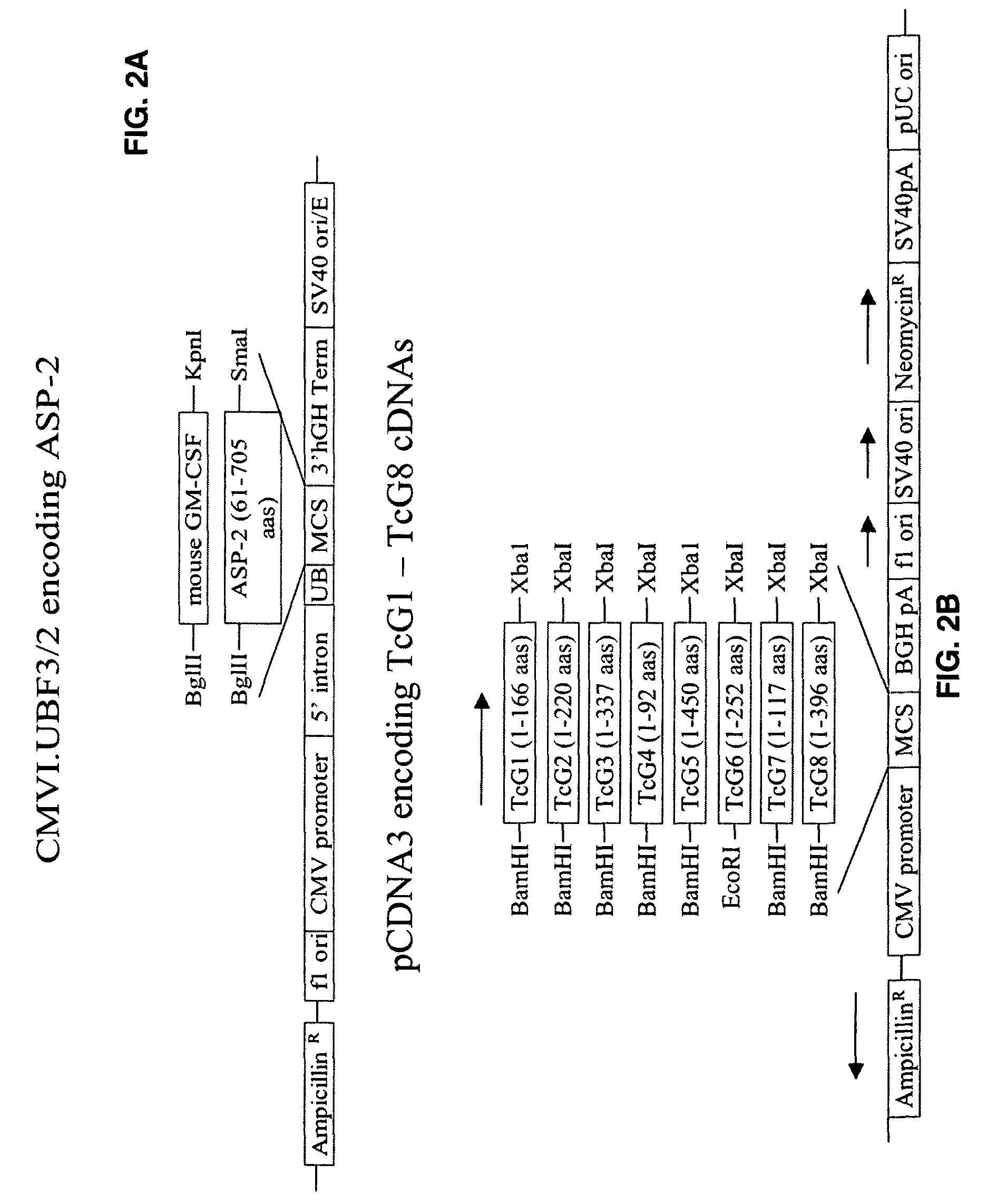Diagnosis and treatment of Trypanosoma cruzi infection and Chagas disease
a technology of trypanosoma cruzi and chagas disease, applied in the field of human and animal health, can solve the problems of ineffective and affordable insecticide use in the long-term, inability to block i>t. cruzi /i>transmission, and no vaccine is available for preventing chagas diseas
- Summary
- Abstract
- Description
- Claims
- Application Information
AI Technical Summary
Benefits of technology
Problems solved by technology
Method used
Image
Examples
example 1
Vaccine Development
[0083]A transfection approach is employed to express ovalbumin (model antigen) in different cellular compartments of T. cruzi. Using these transfectants, it has been demonstrated that parasite secreted antigens and GPI-proteins (released by default in host cell cytoplasm) would be capable of entering the class I and II pathways of antigen presentation and elicit antibody and T cell responses, and, thus, would be the best choice as vaccine candidates [12].
example 2
Computational Screening
[0084]An unbiased computational / bioinformatics approach was developed and the T. cruzi sequence database was screened for the identification of potential vaccine candidates [18] (FIG. 1). This strategy was chosen because testing of ˜8,000 genes, estimated to be present in the haploid genome of T. cruzi (5−8×107 bp), as subunit vaccine candidates was not economically feasible. Strategic analysis of the database led to a selection of 71 candidate sequences of which eight (TcG1-TcG8, Table 1: SEQ ID NOs 2-9) were found to be phylogenetically conserved in clinically important strains of T. cruzi, and expressed in the infective and intracellular stages of the parasite [18]. When delivered as a DNA vaccine in mice, TcG1, TcG2, TcG4 elicited a significant trypanolytic antibody response and Th1 cytokine (IFN-γ), a property associated with immune control of T. cruzi [18] (Table 2). These vaccine candidates, thus, increased the pool of protective vaccine candidates agai...
example 3
Protective Efficacy of TcG1, TcG2, and TcG4 in Mice
[0085]TcG1, TcG2, and TcG4 were cloned in eukaryotic expression vector pcDNA3.1 (for DNA vaccination) and in E. coli expression vector to generate recombinant proteins (for protein vaccination). One group of mice was immunized with four doses of DNA vaccine (pcDNA3 encoding TcG1, TcG2, and TcG4+IL-12 and GM-CSF expression plasmids as illustrated in FIGS. 2A-2F, intramuscular delivery). Second group of mice was immunized with 2 doses of DNA vaccine and 2 doses of recombinant proteins with saponin adjuvant (intradermal). Both groups of mice immunized with DNA-DNA or DNA-protein vaccine elicited anti-parasite humoral and cellular immune responses (FIGS. 3A-3D) [19].
[0086]The DNA-protein vaccine of the present invention induced significantly higher levels of T. cruzi- and antigen-specific humoral responses that were maintained after challenge infection and during chronic disease phase. Likewise, the DNA-protein vaccine elicited a strong...
PUM
| Property | Measurement | Unit |
|---|---|---|
| volume | aaaaa | aaaaa |
| drug resistance | aaaaa | aaaaa |
| agarose gel electrophoresis | aaaaa | aaaaa |
Abstract
Description
Claims
Application Information
 Login to View More
Login to View More - R&D
- Intellectual Property
- Life Sciences
- Materials
- Tech Scout
- Unparalleled Data Quality
- Higher Quality Content
- 60% Fewer Hallucinations
Browse by: Latest US Patents, China's latest patents, Technical Efficacy Thesaurus, Application Domain, Technology Topic, Popular Technical Reports.
© 2025 PatSnap. All rights reserved.Legal|Privacy policy|Modern Slavery Act Transparency Statement|Sitemap|About US| Contact US: help@patsnap.com



